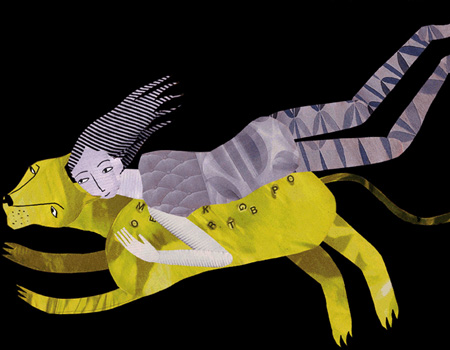School of the Art Institute Animation Professor Chris Sullivan speaks with Laura Heit about her practice.
Chris Sullivan: What options or answers does animation offer you that are different than other medium?
Laura Heit: My work is visual first, and my background is drawing and printmaking—image making—so this is the way I think, the way I form ideas. Animation is a highly constructed medium, intensely so. There is an innate intimacy in a drawn line or a cut piece of paper and I use that as my voice in my work. The evidence of my hand is the film’s quiddity. The addition of time to drawing and collage is what allows me to tell stories. Live action video and photography feels very raw to me; for myself, my films require another layer of translation.
CS: Your films usually have a female protagonist. Why do you think this is so rare?
LH: I have always chosen a woman as the heroine because that’s what I know, and at the very base level, my work always speaks from personal experience.
CS: Who are some of your art heroes, heroines—in animation, writing, filmmaking, whatever?
LH: David Hockney, Gabriel Garcia Marquez, Chris Ware, Lynda Barry, Ingmar Bergman, Guy Madden, Haruki Murakami, Royal Deluxe (giant French Puppets), Hotel Modern (small Dutch puppets), Jim Henson, Hannah Hoch, Italo Calvino, Alexander Calder, Joseph Cornell, Janie Geiser, Prince.
CS: What kind of creative relationship do you have with the people who make music for your films?
LH: Music has always been an important part of my process. I haven’t thought about it much other than that I feel I write stories visually, so music complements it organically—where I feel words or text often explain things when I want ideas to be discovered or examined, rather than told. I was working in theater when I first started making films, and the theater work always had a musical element, so I learned to listen and see in this way. I met musicians through the theater and though a love of live music. Most of my earlier films have Chicago musicians I met at the Empty Bottles Free Jazz Tuesdays. I’ve built relationships this way, and when developing a film, I consider the composer/musician early in the process. Then throughout the filmmaking process, it’s a constant dialogue.
CS: Can you talk a bit about the difference between the independent animators world in the U.S. vs. Great Britain?
LH: I went to grad school in London at the Royal College of Art, and stayed on after I graduated to work on a short film commissioned by Channel 4 films and produced by Slinky Pictures. I stayed and worked as an animation director for Slinky for a while after that. London is an amazing place for an animation artist. For twenty years, Channel 4 television was funding independent animation on a very regular basis, so there was a real system of support for new work to be made (a book by Clare Kitson just came out about this). Because of this, there are many small studios of 3-5 people (usually classmates from Royal College of Art). These studios have a great camaraderie—while they are in competition with each other, they are all in favor of keeping the world of independent animation alive. There is a closer relationship with filmmaking than with commercial work. These smaller studios produce short films by their directors whenever they get the chance. Also, the British have a greater appreciation for this kind of work—agencies and television want and expect a more art-based approach to the work when they ask for pitches from animation studios. Here in the States, we are (mostly) run by HUGE studios with a huge reliance on consumer research and fear of the bottom line; the studios here are far less likely to take a risk.
CS: What do you have on the burner these days?
LH: I’m working very slowly on a few projects at the moment. One is a graphic novel based on a true story–it’s about a Succubus and the boy whose soul she must steal. Another is a short film and performance that features a series of cycles, of a woman and a wolf. The animation is done in silhouette using cutouts under the camera and layered with drawings and a collection of long exposure sequences of light through trees at dusk. The loops repeat and change speed altering the translation of the action. A visual dichotomy of fear and desire. This piece works with a singer whose beautiful and eerie voice emulates distant howls.
CS: What’s with the tigers?
LH: I was born in the year of the tiger. Is that what you mean?
